
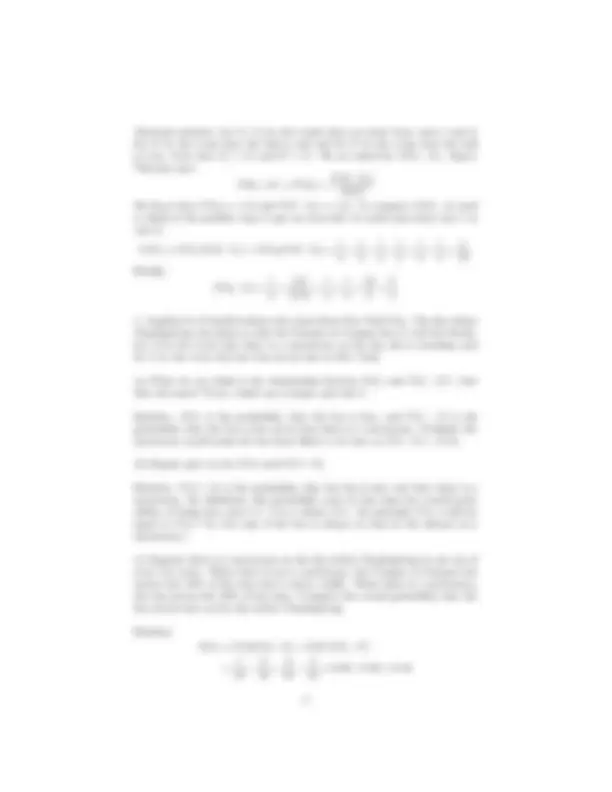
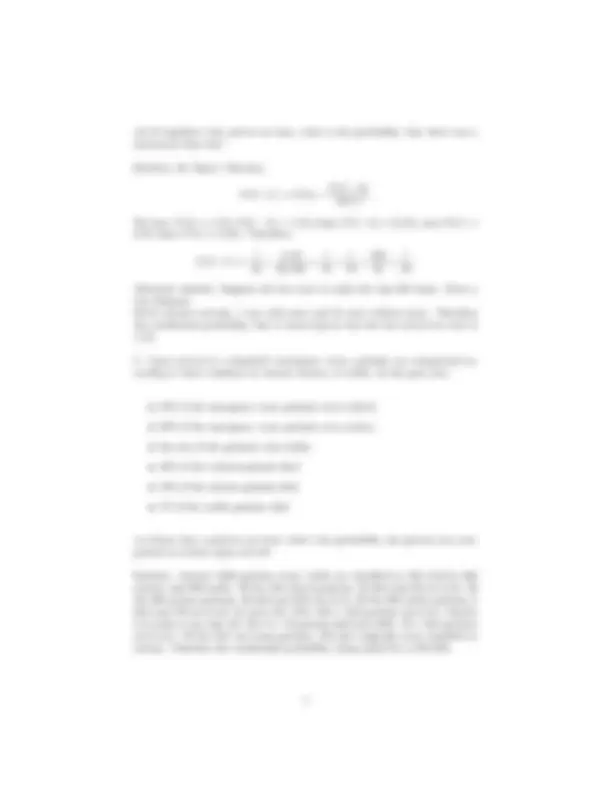
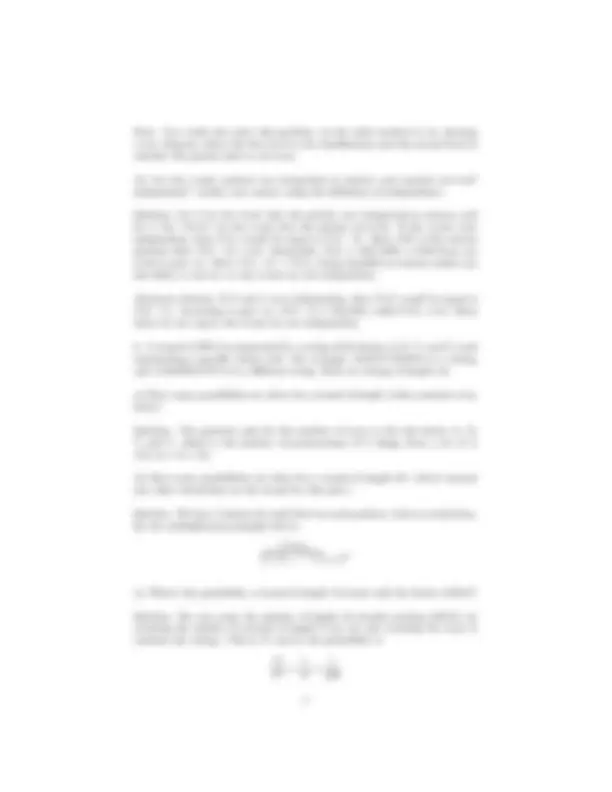
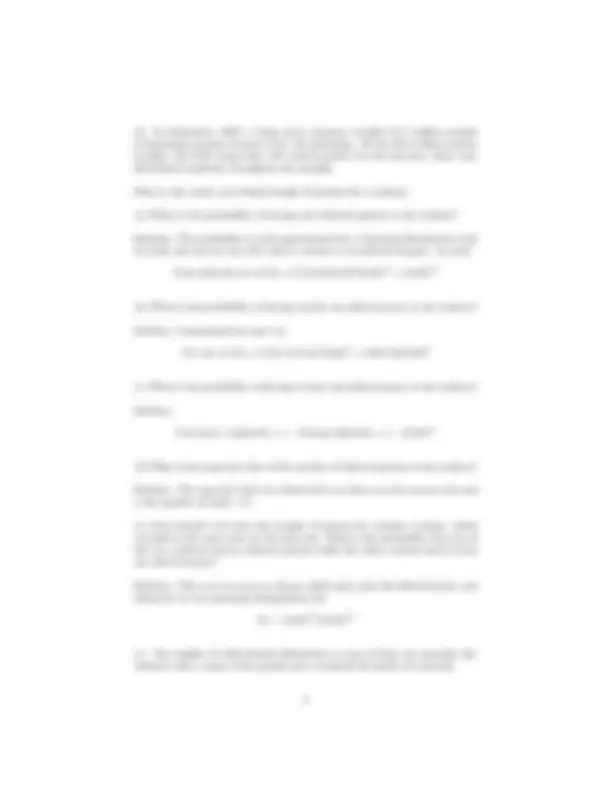
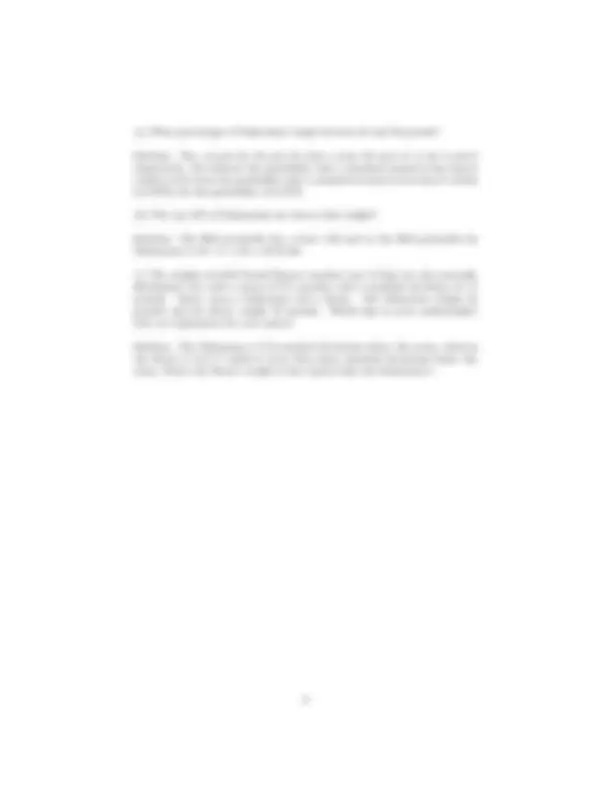


Study with the several resources on Docsity

Earn points by helping other students or get them with a premium plan


Prepare for your exams
Study with the several resources on Docsity

Earn points to download
Earn points by helping other students or get them with a premium plan
Community
Ask the community for help and clear up your study doubts
Discover the best universities in your country according to Docsity users
Free resources
Download our free guides on studying techniques, anxiety management strategies, and thesis advice from Docsity tutors
Solution: Draw a Venn diagram with probabilities. If A corresponds to the students who take agriculture and P corresponds to the students who take propulsion, ...
Typology: Study notes
1 / 9

This page cannot be seen from the preview
Don't miss anything!






(a) Sets A, B and C so that A ∪ C = B ∪ C, but A 6 = B.
Solution: Many answers are possible. One choice is A = { 1 , 2 , 3 }, B = { 2 , 3 , 4 }, C = { 1 , 4 }. Both A ∪ C and B ∪ C are { 1 , 2 , 3 , 4 }.
(b) Sets A and B so that A ∩ B = A.
Solution: As long as A ⊆ B, this will be true. We could take A = { 1 , 2 , 3 } and B = { 1 , 2 , 3 , 4 , 5 }.
Solution: Draw a Venn diagram with probabilities. If A corresponds to the students who take agriculture and P corresponds to the students who take propulsion, we fill in the diagram as follows:
First enter 1/5 on the left. Second, since the total probability of A is 1/2, the middle region has probability 1/ 2 − 1 /5 = 3/10. Third, since the total probability of P is 7/10, the right region has probability 7/ 10 − 3 /10 = 4/10. Finally, the sum of all the probabilities is 1, so there is 1/10 probability left over for the outer region.
(a) What’s the probability a randomly chosen incoming student is taking both courses?
Answer: 3/ 10
(b) What’s the probability a randomly chosen student is taking either agricul- ture or propulsion?
Answer: 1/5 + 3/10 + 4/10 = 9/ 10
(c) Given that a student is taking agriculture, what’s the probability they are also taking propulsion?
Answer:
(d) Are there any incoming students that are not taking either course? Briefly explain your answer.
Answer: Yes, 1/10 of the students are not taking either course, since we already said in part (b) that 9/10 of the students are taking one or the other.
(a) Write down a sample space S for the experiment where you choose one ball from the first vase and one ball from the second.
Answer:
S = {(1, 1), (1, 2), (1, 3), (1, 4), (2, 1), (2, 2), (2, 3), (2, 4), (3, 1), (3, 2), (3, 3), (3, 4)}.
(b) Let x be the sum of the numbered labels on the two balls that you draw. Write down the probability distribution for the value of x.
Answer: P (x = 2) = 1/12, P (x = 3) = 2/12, P (x = 4) = 3/12, P (x = 5) = 3 /12, P (x = 6) = 2/12, P (x = 7) = 1/12.
(c) Compute the mean (expected value) of x.
Solution:
E(x) = 2 ×
Alternate solution: The mean value of the first ball is 2, and the mean value of the second ball is 2.5. Therefore the mean value of the sum is 2 + 2.5 = 4.5.
(d) Now suppose someone picks one of the vases at random (probability 1/ 2 each) and draws a random ball out of that vase. Given that the ball has an even value, what is the probability the ball came from the second vase?
Solution: Suppose you were to run this experiment 12 times. On average you would choose the first vase 6 times and the second vase 6 times. When you choose the first vase, you have 2/3 probability of drawing an odd number and 1 /3 probability of drawing an even number. When you choose the second vase, you have 1/2 probability of odd and 1/2 probability of even. Draw a tree diagram: Overall, you draw an even value in 5 of the 12 trials. Of those 5 even balls, 2 came from vase 1 and 3 came from vase 2. Therefore the conditional probability that the ball came from vase 2 given that it has an even number is 3/5.
(d) If Angelica’s bus arrives on time, what is the probability that there was a snowstorm that day?
Solution: By Bayes’ Theorem,
We have P (S) = 1/10, P (L′^ | S) = 1/10 (since P (L | S) = 9/10), and P (L′) = 0 .55 (since P (L) = 0.45). Therefore,
Alternate solution: Suppose the bus were to make the trip 100 times. Draw a tree diagram: Of 55 on-time arrivals, 1 was with snow and 54 were without snow. Therefore the conditional probability that it snowed given that the bus arrived on time is 1 /55.
(a) Given that a patient survived, what’s the probability the patient was cate- gorized as serious upon arrival?
Solution: Assume 1000 patients total, which are classified as 100 critical, 300 serious, and 600 stable. Of the 100 critical patients, 40 died and 60 survived. Of the 300 serious patients, 30 died and 270 survived. Of the 600 stable patients, 6 died and 594 survived. In total, 60 + 270 + 594 = 924 patients survived. (Maybe it is easier to say that 40+30+6 = 76 patients died and 1000−76 = 924 patients survived.) Of the 924 surviving patients, 270 had originally been classified as serious. Therefore the conditional probability being asked for is 270/924.
Note: You could also solve this problem via the table method or by drawing a tree diagram where the first level is the classification and the second level is whether the patient died or survived.
(b) Are the events ‘patient was categorized as serious’ and ‘patient survived’ independent? Justify your answer using the definition of independence.
Solution: Let S be the event that the patient was categorized as serious, and let L (for “lived”) be the event that the patient survived. If the events were independent, then P (L) would be equal to P (L | S). Since 10% of the serious patients died, P (L | S) = 0.9. Meanwhile, P (L) = 924/1000 = 0.924 from our work in part (a). Since P (L | S) < P (L), being classified as serious makes you less likely to survive, so the events are not independent.
Alternate solution: If S and L were independent, then P (S) would be equal to P (S | L). According to part (a), P (S | L) = 270/924, while P (S) = 0.3. Since these are not equal, the events are not independent.
(a) How many possibilities are there for a strand of length 4 that contains every letter?
Solution: The question asks for the number of ways to list the letters A, G, T and C, which is the number of permutations of 4 things from a set of 4, P (4, 4) = 4! = 24.
(b) How many possibilities are there for a strand of length 10? (Don’t assume any other restrictions on the strand for this part.)
Solution: We have 4 choices for each letter in each position, with no restrictions. By the multiplication principle this is
10 times ︷ ︸︸ ︷ 4 × 4 × · · · × 4 = 4^10
(c) What’s the probability a strand of length 10 starts with the letters AGGA?
Solution: We can count the number of length 10 strands starting AGGA, by counting the number of strands of length 6 (we are just counting the ways to continue the string). This is 4^6 , and so the probability is
46 410
(a) Find the mean number of siblings for this group of students.
Solution: There are 22 people responding to the survey, so the mean is
2 · 0 + 5 · 1 + 8 · 2 + 7 · 3 22
(b) Find the median number of siblings for this group of students.
Solution: With 22 responses, the median falls between the 11th and 12th data value. Both of these have two siblings, for a median of 2.
(a) What’s the expected payout of the game?
Solution: The random variable x which represents your net winnings is
Value of die Change in $ 1 12 − 6 = 6 2 12 − 6 = 6 3 6 − 6 = 0 4 0 − 6 = − 6 5 0 − 6 = − 6 6 0 − 6 = − 6
Each outcome has probability 1/6 and so
E(x) =
(b) Based on the expected payout, is this a good game to play? Briefly justify your answer.
Solution: The expected payout of the game is negative, meaning we would expect to lose money (in the long run) playing this game. It is not a good game to play.
Prior to the recall, your friend bought 10 patties for a cookout.
(a) What is the probability of having zero infected patties at the cookout?
Solution: The probability is well approximated by a binomial distribution with 10 trials and success rate 12% (here a success is an infected burger). As such
P (no infected out of 10) = C(10, 0)(0.12)^0 (0.88)^10 = (0.88)^10
(b) What is the probability of having exactly one infected patty at the cookout?
Solution: Continuing from part (a)
P (1 out of 10) = C(10, 1)(0.12)^1 (0.88)^9 = 10(0.12)(0.88)^9
(c) What is the probability of having at least one infected patty at the cookout?
Solution:
P (at least 1 infected) = 1 − P (none infected) = 1 − (0.88)^10
(d) What is the expected value of the number of infected patties at the cookout?
Solution: The expected value of a binomial is np where p is the success rate and n the number of trials: 1. 2
(e) Your friend’s evil twin also bought 10 patties for another cookout, which was held at the same time on the same day. What is the probability that one of the two cookouts had no infected patties while the other cookout had at least one infected patty?
Solution: There are two ways to choose which party gets the infected patty, and otherwise we are assuming independence for
2(1 − (0.88)^10 )(0.88)^10